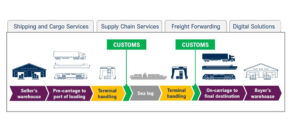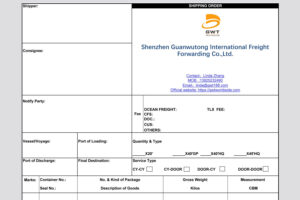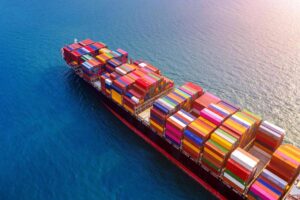Conocimientos desde la recogida del contenedor vacío hasta el proceso de carga del contenedor
Comprenda el proceso de carga de contenedores para controlar mejor su envío y el transporte de mercancías.
Conozca el proceso de envío marítimo Premium de GWT Worldwide

Comprender el proceso de recogida de contenedores en China
Operaciones portuarias en China
Navegar por el proceso de recogida de contenedores en China exige un conocimiento exhaustivo de sus principales puertos, cada uno de ellos un bullicioso centro del comercio mundial. Shanghái, por ejemplo, es el puerto más activo del mundo, caracterizado por su avanzada tecnología y sus eficientes operaciones. Familiarizarse con su diseño y terminales específicas puede mejorar significativamente la experiencia logística. Del mismo modo, Shenzhen es una puerta de entrada crucial para el sur de China, con terminales como Yantian y Shekou, conocidas por sus procesos racionalizados. Ningbo, estratégicamente situada en el delta del río Yangtsé, ofrece capacidades de aguas profundas ideales para grandes buques, lo que la convierte en un eslabón fundamental del transporte marítimo internacional.
Logística y normativa portuarias
Es esencial comprender la logística y la normativa portuarias. Los procedimientos aduaneros en China exigen una atención meticulosa a los detalles, con documentos clave como el conocimiento de embarque y la factura comercial necesarios para el despacho. La contratación de un agente de aduanas puede facilitar este proceso y garantizar el cumplimiento de la normativa de importación y exportación. Además, el conocimiento de las tasas portuarias, incluidos los gastos de manipulación en la terminal y las tasas de almacenamiento, es crucial para la elaboración del presupuesto. La mayoría de los puertos operan 24 horas al día, 7 días a la semana, pero conocer las horas concretas de servicio puede ayudar a planificar las recogidas en horas valle, reduciendo así los tiempos de espera y mejorando la eficiencia.
Precauciones para los distintos tipos de mercancías
Cuando se trata de distintos tipos de mercancías, hay que tomar precauciones específicas. Los productos perecederos, por ejemplo, requieren contenedores con unidades de refrigeración fiables. Controlar la temperatura es vital para mantener la calidad del producto, y dar prioridad a un despacho y transporte rápidos puede evitar que se estropee. Los materiales peligrosos requieren un estricto cumplimiento de las normas de seguridad, incluido un embalaje y etiquetado adecuados. Obtener los permisos necesarios con antelación es fundamental, al igual que asegurarse de que el personal está bien formado en la manipulación de estos materiales. En el caso de artículos de gran valor, es aconsejable aplicar medidas de seguridad como el seguimiento por GPS y precintos de seguridad. Evaluar las opciones de seguro para cubrir posibles pérdidas protege aún más estos valiosos envíos.
Colaboración con socios locales
La colaboración con socios locales puede mejorar mucho el proceso de recogida de contenedores. Seleccionar proveedores logísticos con una fuerte presencia local y experiencia garantiza la fiabilidad y la eficiencia. Su conocimiento de la normativa y la logística locales puede ser inestimable, y el establecimiento de canales de comunicación claros ayuda a abordar cualquier problema con prontitud. Es igualmente importante establecer relaciones con las autoridades portuarias. El compromiso y la comunicación regulares pueden mantenerle informado sobre los cambios de procedimiento, mientras que la asistencia a eventos del sector le ayuda a mantenerse al día sobre los avances. Estas relaciones pueden facilitar las operaciones y contribuir a una experiencia logística más fluida.
Comprendiendo estos aspectos, las empresas pueden navegar por las complejidades de los puertos chinos con mayor eficacia, mejorando la eficiencia y reduciendo los posibles retrasos. Este enfoque integral garantiza un proceso de recogida de contenedores más fluido, mejorando en última instancia la gestión global de la cadena de suministro.
Por supuesto. Aquí está la continuación del artículo con contenido ampliado bajo cada titular:
Preparativos para la recogida de contenedores
Documentación y conformidad
Antes de iniciar el proceso de recogida del contenedor, es crucial asegurarse de que toda la documentación necesaria está en orden. Esto incluye el conocimiento de embarque, la factura comercial y la lista de empaque. Cada documento debe reflejar con exactitud los detalles del envío para evitar retrasos. Es aconsejable trabajar en estrecha colaboración con un agente de aduanas que pueda navegar por las complejidades de la normativa china de importación y exportación y garantizar el cumplimiento de las leyes locales. Este paso es vital para un despacho de aduanas sin problemas y para evitar posibles multas o sanciones.
Programación y coordinación
Una programación y coordinación eficaces son la clave de una recogida eficaz de los contenedores. Esto implica alinear la llegada del buque con la disponibilidad de recursos de transporte. Utilice sistemas digitales de seguimiento para supervisar los horarios de los buques y anticiparse a cualquier cambio. La coordinación con los transitarios y los proveedores de transporte locales garantiza que los camiones estén listos para transportar los contenedores en cuanto se autorice su salida. De este modo se minimizan los tiempos de espera y se optimiza el uso de los recursos, lo que se traduce en una operación más ágil.
Procedimientos in situ en el puerto
Inspección y manipulación de contenedores
A su llegada al puerto, los contenedores se someten a una inspección para verificar su estado y contenido. Este proceso implica la comprobación de cualquier daño que pueda haberse producido durante el tránsito. La utilización de tecnología como las etiquetas RFID puede facilitar un seguimiento y una manipulación eficaces. El personal portuario está formado para manipular los contenedores con cuidado, pero también es importante que su equipo esté presente para supervisar el proceso y asegurarse de que todos los protocolos se siguen correctamente.
Proceso de carga y sujeción de contenedores. Proceso importante de carga de contenedores
La carga del contenedor en los vehículos de transporte requiere precisión y el cumplimiento de las normas de seguridad. Es esencial sujetar correctamente el contenedor para evitar que se mueva durante el transporte, lo que puede provocar daños. El uso de equipos de sujeción adecuados, como cierres giratorios y correas de amarre, garantiza la estabilidad del contenedor. La formación del personal en prácticas seguras de carga es fundamental para mantener la integridad del envío y garantizar el cumplimiento de las normas de seguridad.
Logística posterior a la recogida
Transporte y entrega
Una vez recogido el contenedor, la siguiente prioridad es un transporte eficiente hasta su destino final. Elegir el modo de transporte adecuado -por carretera, ferrocarril o una combinación de ambos- depende de factores como la distancia, el coste y la urgencia. La implantación de sistemas de seguimiento por GPS permite controlar el envío en tiempo real, lo que aporta transparencia y permite informar puntualmente a los clientes. Garantizar que los vehículos de transporte estén bien mantenidos y que los conductores tengan experiencia contribuye a un proceso de entrega sin problemas.
Gestión de retrasos y problemas
A pesar de una planificación meticulosa, pueden producirse retrasos imprevistos. Disponer de un plan de contingencia es esencial para hacer frente a problemas como la congestión del tráfico, las averías de los equipos o las retenciones reglamentarias. Establecer canales de comunicación sólidos con todas las partes interesadas permite resolver rápidamente los problemas y minimizar las interrupciones. La flexibilidad y la adaptabilidad son fundamentales para mantener la eficiencia y cumplir los plazos de entrega.
El artículo presenta un amplio conocimiento del proceso de carga de contenedores.
Devolver un contenedor lleno
Programación de la devolución
Devolver un contenedor lleno implica una programación cuidadosa para alinearse con las operaciones portuarias y evitar cargos por sobrestadía. Es esencial coordinarse con las navieras y las autoridades portuarias para determinar las franjas horarias disponibles para la devolución de contenedores. Utilizar plataformas digitales para reservar franjas horarias de devolución puede agilizar este proceso y proporcionar actualizaciones en tiempo real sobre la disponibilidad. Planificar con antelación y respetar el calendario de devoluciones ayuda a evitar tasas adicionales y garantiza una transición fluida.
Documentación para la devolución
La documentación adecuada es crucial a la hora de devolver un contenedor lleno. Los documentos clave, como la orden de entrega y el formulario de liberación del contenedor, deben cumplimentarse con precisión. Estos documentos confirman la devolución del contenedor y garantizan que se recibe en buenas condiciones. Colaborar con los agentes de aduanas puede ayudar a verificar que toda la documentación está en orden, reduciendo el riesgo de retrasos o discrepancias durante el proceso de devolución.
Inspección y evaluación del estado
Antes de devolver un contenedor, es esencial realizar una inspección minuciosa para evaluar su estado. Esto implica comprobar si se han producido daños durante la descarga o el tránsito. Documentar el estado con fotos e informes puede servir de prueba en caso de litigio. También es importante asegurarse de que el contenedor está limpio y libre de residuos, ya que los puertos pueden imponer tasas de limpieza si los contenedores no se devuelven en condiciones aceptables.
Logística de transporte
Organizar el transporte para la devolución de un contenedor lleno requiere una cuidadosa coordinación. Es vital elegir proveedores de transporte fiables con experiencia en la gestión de devoluciones de contenedores. Los sistemas de seguimiento en tiempo real pueden supervisar el progreso del viaje de vuelta, garantizando la entrega puntual en el puerto designado. Una gestión logística eficaz minimiza los retrasos y contribuye a un proceso de devolución sin contratiempos.
Gestión de problemas inesperados
A pesar de una planificación minuciosa, pueden surgir problemas inesperados durante el proceso de retorno de los contenedores. Por ejemplo, retrasos en el tráfico, averías en los equipos o cambios en los horarios portuarios. Contar con un plan de contingencia y mantener una comunicación abierta con todas las partes implicadas puede ayudar a abordar estos retos con prontitud. La flexibilidad y la resolución proactiva de los problemas son fundamentales para minimizar las interrupciones y garantizar el éxito de la devolución.
El proceso de devolución de un contenedor lleno es tan crítico como la recogida inicial. Centrándose en una programación precisa, una documentación exacta y unas inspecciones minuciosas, las empresas pueden garantizar un proceso de devolución sin problemas. Una logística de transporte eficaz y la capacidad de gestionar retos inesperados mejoran aún más la eficiencia de las devoluciones de contenedores. Este enfoque integral no sólo reduce los costes, sino que también fortalece las relaciones con los socios navieros y las autoridades portuarias, contribuyendo a una cadena de suministro más sólida.
Conclusión
Navegar con éxito por el proceso de recogida de contenedores en China implica un profundo conocimiento de las operaciones portuarias, una preparación meticulosa y una coordinación eficaz. Al centrarse en el cumplimiento, aprovechar la tecnología y crear sólidas asociaciones locales, las empresas pueden mejorar sus operaciones logísticas y garantizar la entrega puntual y eficiente de las mercancías. Este enfoque integral no sólo mejora la eficiencia de la cadena de suministro, sino que también fortalece las relaciones con socios y clientes, contribuyendo en última instancia al éxito empresarial.
































